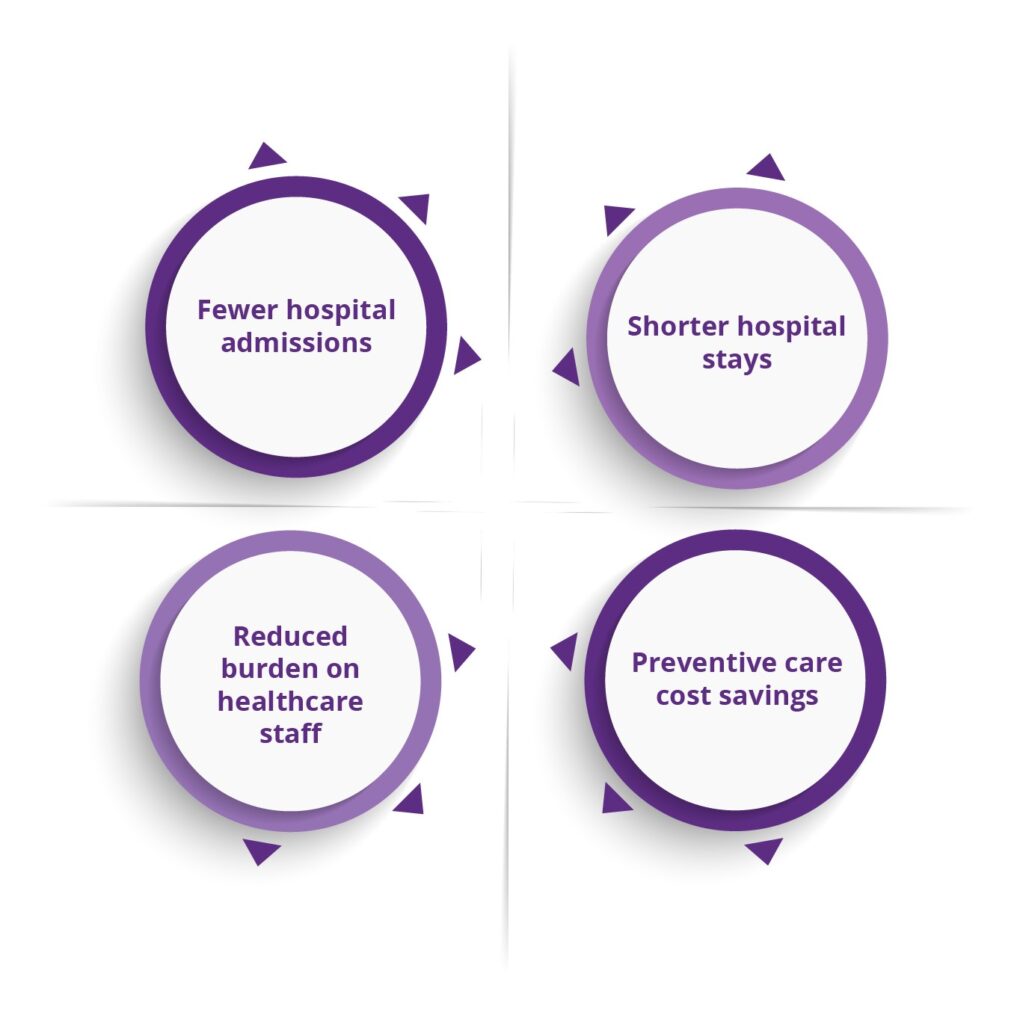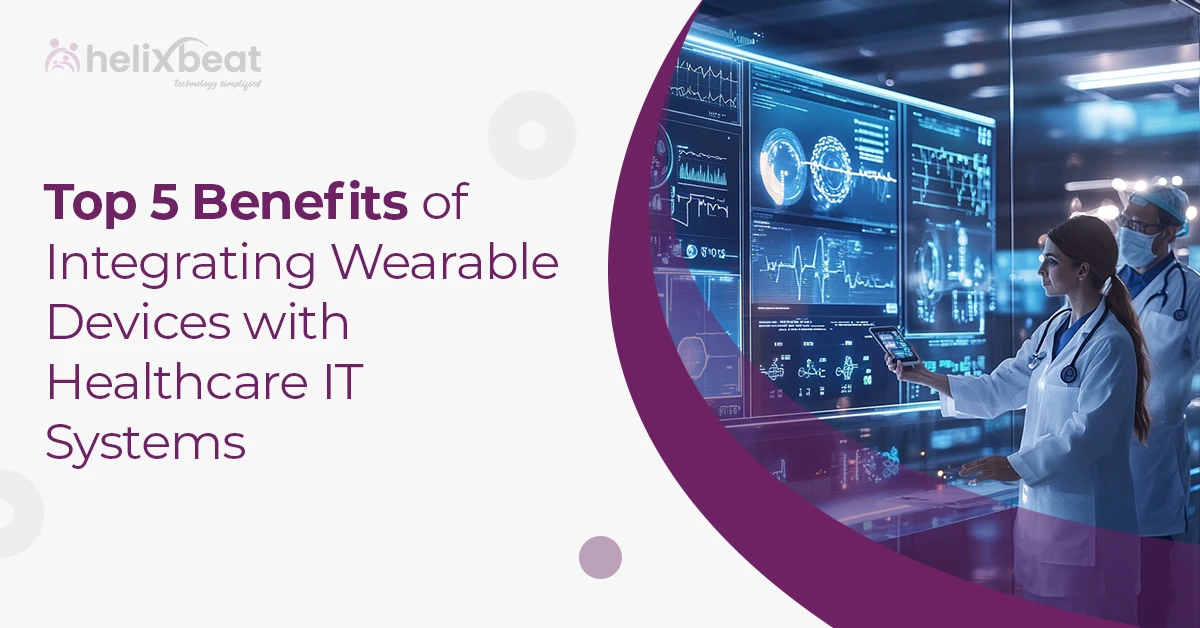Wearable health monitoring devices, from fitness trackers to smartwatches, have changed how people monitor their well-being. These devices collect real-time health data and offer valuable insights. However, their true potential is unlocked when integrated with Healthcare IT systems. Connecting wearable devices to Electronic Health Records (EHRs) creates a seamless flow of health data between patients and healthcare providers.
This fusion of wearable tech and healthcare IT is making patient care more personalized, data-driven, and proactive. Here’s a deep dive into the top five benefits of integrating wearable health monitoring devices with Healthcare IT systems.
Table of Contents
Top 5 Benefits of Integrating Wearable Devices
1. Real-Time Health Monitoring and Early Detection of Medical Conditions
Wearable health monitoring devices track vital signs such as heart rate, blood pressure, blood oxygen levels, glucose levels, and ECG patterns. When these metrics sync with healthcare IT systems, healthcare providers gain access to real-time patient data, which helps them detect anomalies early.
Real-time monitoring also benefits individuals managing chronic conditions.
For example, many wearable continuous glucose monitors (CGMs) can transmit blood sugar readings to patient portals and may be capable of transmitting data directly to some Electronic Health Records (EHR) systems.
As a result, it helps doctors make more informed treatment decisions, such as adjustments to medication, insulin dosing, and lifestyle recommendations.
2. Improved Patient Engagement and Self-Management
Integrating wearable health monitoring devices with healthcare IT platforms empowers patients to participate actively in their health. Unlike traditional care models, where patients visit doctors only when symptoms appear, wearable data encourages continuous monitoring and engagement.
Patients can track their daily activity levels, heart rates, sleep patterns, and other key metrics through apps connected to their wearable devices. These insights help them understand their health trends and motivate them to adopt healthier lifestyles.
Additionally, healthcare providers can set personalized health goals for patients, such as maintaining a target step count, reducing sedentary time, or improving sleep quality. These goals, combined with real-time feedback from wearable devices, help patients stay committed to their health journeys.
With wearables integrated into healthcare IT, patients become active participants rather than passive recipients of medical care.
3. Enhanced Remote Patient Monitoring and Telehealth Efficiency
The rise of telehealth and remote patient monitoring (RPM) has made healthcare more accessible and convenient. Wearable health monitoring devices play a critical role in bridging the gap between patients and healthcare providers, especially for individuals in remote or underserved areas.
For patients with chronic illnesses or post-surgical recovery needs, wearables allow doctors to track health metrics without requiring in-person visits. For example, hypertensive patients can wear smart blood pressure monitors that sync with telehealth platforms. On the other hand, COPD or asthma patients using oxygen saturation monitors can receive alerts and guidance based on their real-time oxygen levels.
As a result, doctors can review the readings remotely and adjust treatments accordingly. This not only saves time and costs but also provides continuous, data-backed healthcare to providers wherever they are.
4. Optimized Clinical Decision-Making with AI and Big Data Analytics
When wearable health monitoring devices sync with Healthcare IT systems, they generate vast amounts of health data. With the help of AI-driven analytics, this data becomes a powerful tool for clinical decision-making and medical research.
Big Data algorithms can analyze patient trends and identify patterns that may not be visible during routine check-ups. This can help doctors make more precise diagnoses, tailor treatment plans, and predict health risks.
Additionally, population health management can also benefit from wearable data integration. This can help the health systems identify high-risk groups, track disease prevalence, and develop preventive care strategies.
With AI and predictive analytics, wearable-integrated healthcare IT shifts from a one-size-fits-all model to highly personalized, data-driven care.
5. Reduced Healthcare Costs and Operational Efficiency
One of the biggest advantages of integrating wearable health monitoring devices with Healthcare IT is its impact on healthcare costs and system efficiency. By preventing complications, reducing hospital visits, and optimizing workflows, wearable technology helps hospitals and clinics streamline operations while cutting down expenses.

How does this happen?
- Fewer hospital admissions: Continuous remote monitoring helps detect early warning signs and prevents costly emergency interventions.
- Shorter hospital stays: Post-surgery patients using recovery monitoring wearables can be discharged earlier while still being observed remotely.
- Reduced burden on healthcare staff: Automated health alerts from wearables assist doctors and nurses in prioritizing high-risk patients, leading to better resource allocation.
- Preventive care cost savings: Wearable-integrated preventive health programs encourage lifestyle improvements and reduce the need for expensive treatments down the line.

A 2024 study published in JMIR Formative Research found that home telemonitoring significantly reduced hospital readmissions and emergency department visits among high-risk post-discharge patients. Therefore, the wearable healthcare revolution is only beginning. As technology advances, we can expect even smarter, more intuitive wearables that seamlessly integrate with AI-powered Healthcare IT systems.
Final Thoughts
Integrating wearable health monitoring devices with Healthcare IT systems is not just about collecting data—it’s about turning real-time health insights into actionable medical decisions. However, bridging the gap between wearable technology and healthcare IT systems requires robust, interoperable solutions. Helixbeat offers cutting-edge FHIR-compatible integration tools that effortlessly connect wearable devices with your EHR and digital health platforms. By streamlining data exchange and enhancing real-time insights, Helixbeat empowers healthcare providers to leverage wearables for better patient outcomes.
If you’re ready to transform healthcare with smart, connected wearables, discover how Helixbeat can help you build a future-ready healthcare ecosystem today!
FAQs
1. How do wearable health monitoring devices integrate with Healthcare IT systems?
Wearables sync with Electronic Health Records (EHRs) and healthcare IT platforms using wireless connectivity, cloud storage, and APIs. This integration allows real-time data sharing between patients and healthcare providers.
2. What are the benefits of real-time health monitoring?
Real-time monitoring helps detect early signs of health issues, assists in chronic disease management, and provides doctors with continuous patient data for more informed medical decisions.
3. How does wearable technology improve patient engagement?
Through apps connected to their wearable health monitoring devices, patients can track their daily health metrics, set personal wellness goals, and stay actively involved in their treatment plans.
4. How does wearable integration support remote patient monitoring?
Wearables help doctors monitor patients without in-person visits, allowing timely interventions for those recovering from surgeries or managing chronic illnesses like hypertension and diabetes.
5. Can wearable data improve clinical decision-making?
Yes, AI and big data analytics can use wearable-generated data to identify trends, refine treatment plans, and provide predictive insights for better healthcare management.
6. How does wearable technology contribute to telehealth?
Wearables provide real-time patient data to telehealth platforms, thus allowing doctors to monitor symptoms, adjust treatments, and offer virtual consultations.
7. What role does Helixbeat play in wearable device integration?
Helixbeat offers FHIR-compatible integration tools that connect wearable devices with EHRs and digital health platforms, thus streamlining real-time data exchange and improving patient outcomes.
8. Does integrating wearables reduce healthcare costs?
By minimizing emergency visits, hospital readmissions, and unnecessary procedures, wearables contribute to cost savings for both patients and healthcare systems.
9. What are wearable health monitoring devices?
Wearable health monitoring devices include fitness trackers, smartwatches, and medical-grade wearables that collect real-time data on vital signs like heart rate, blood pressure, oxygen levels, and glucose levels.














